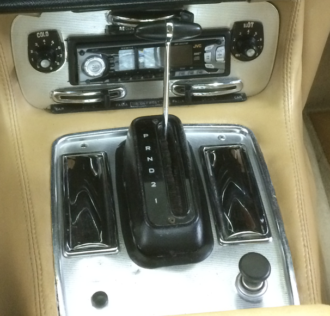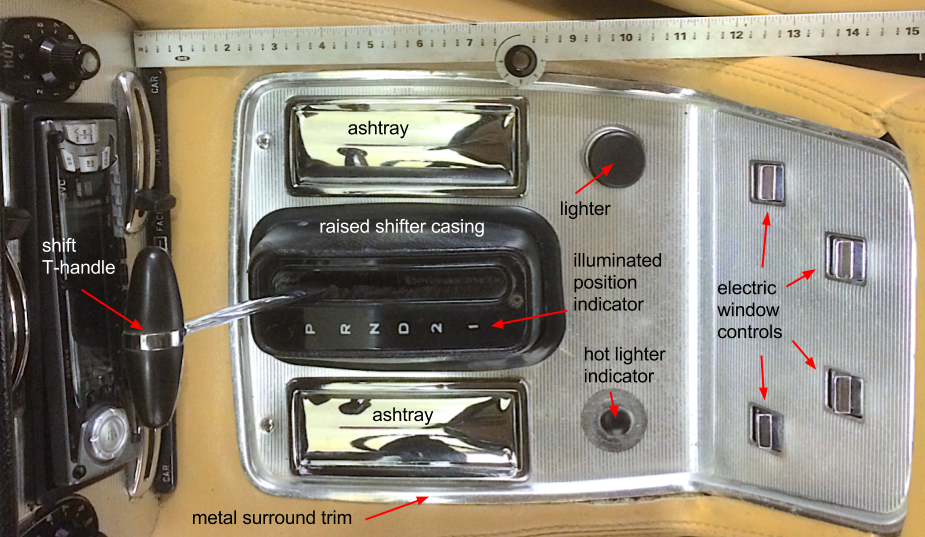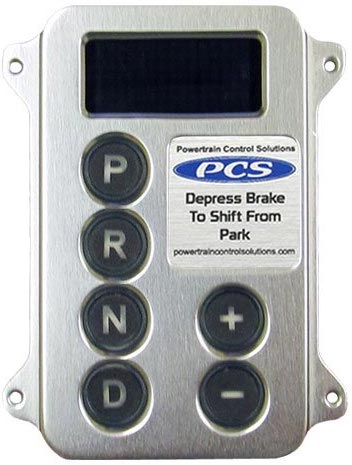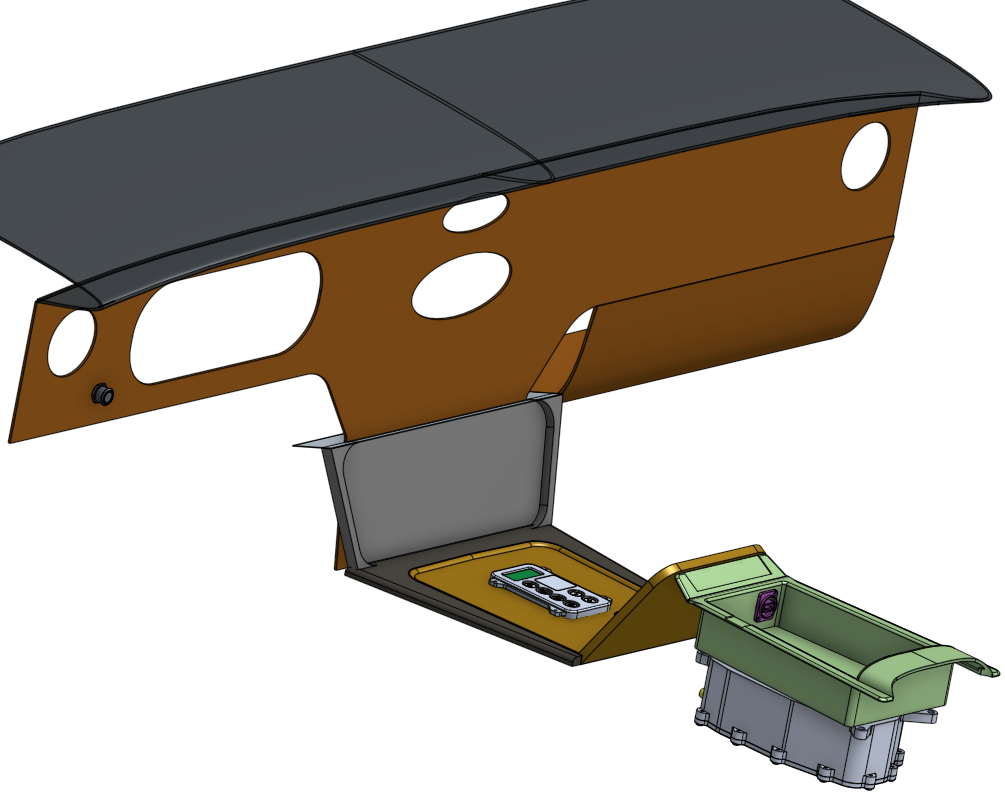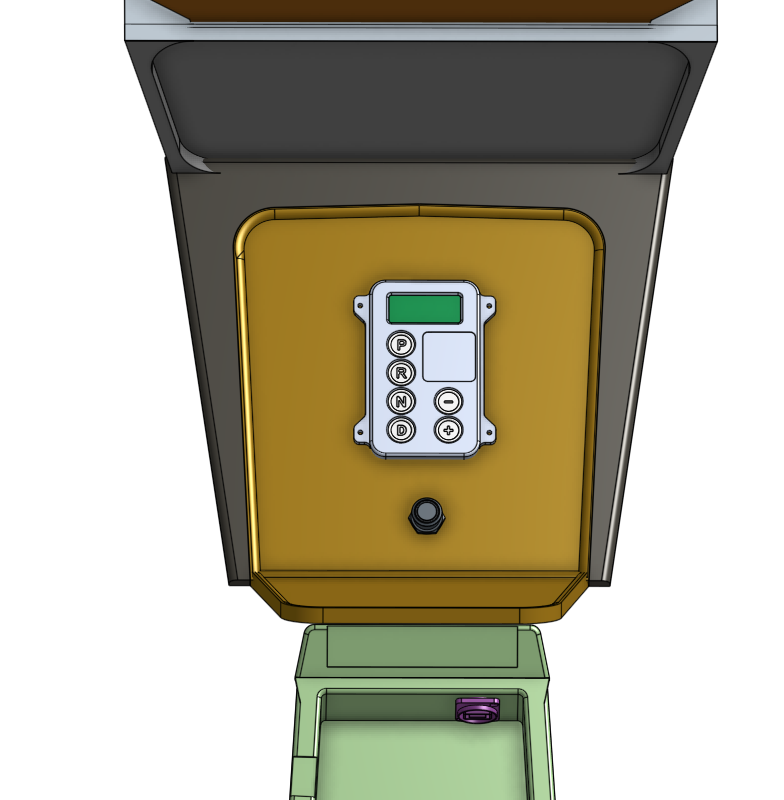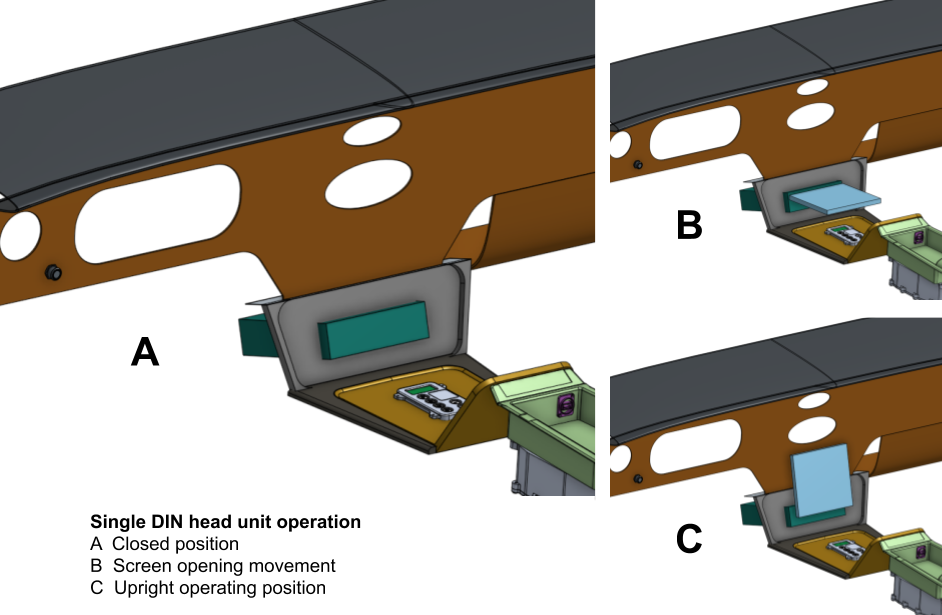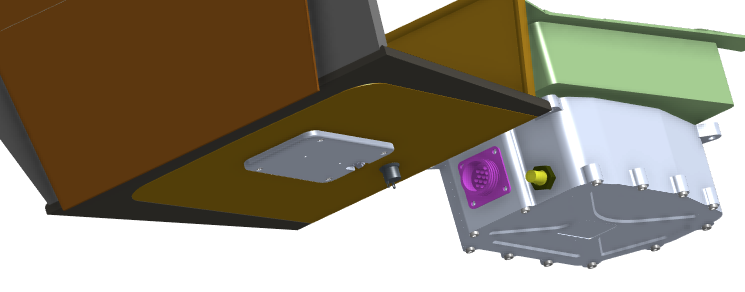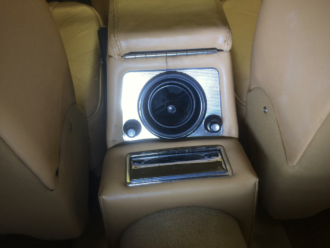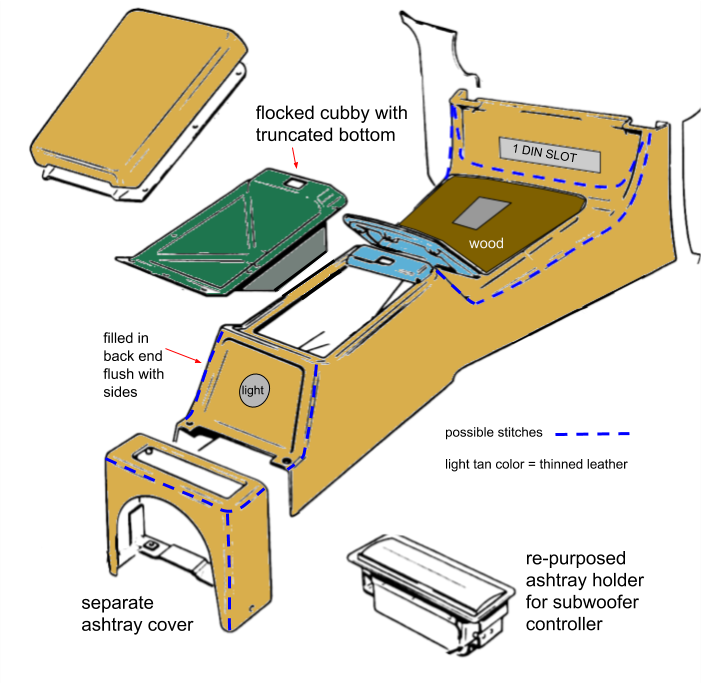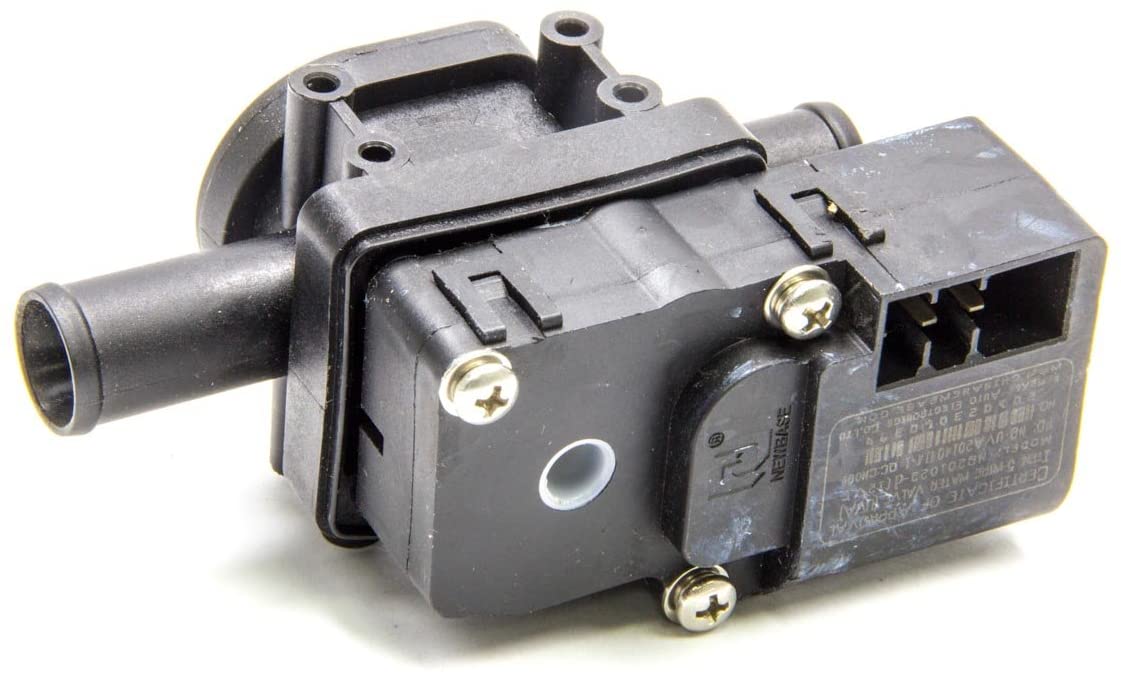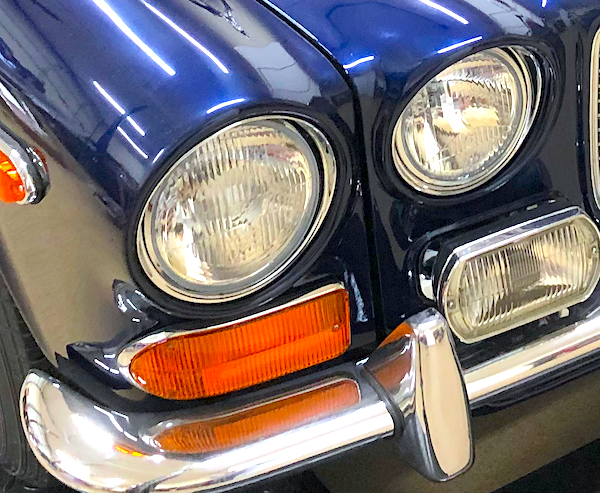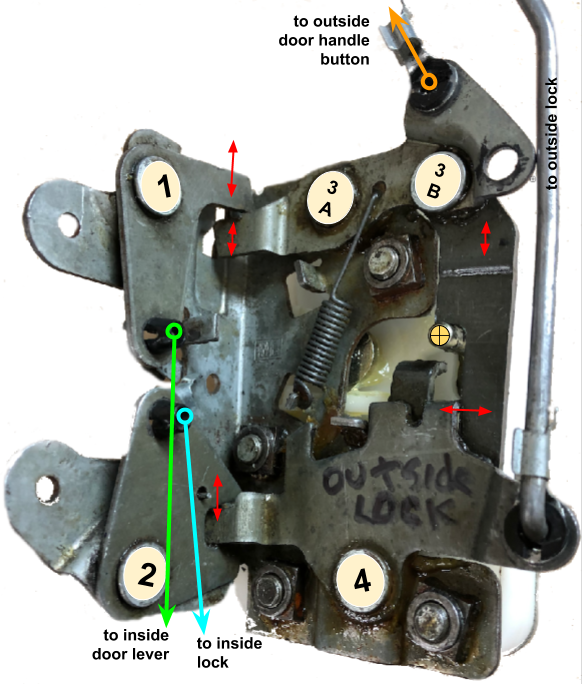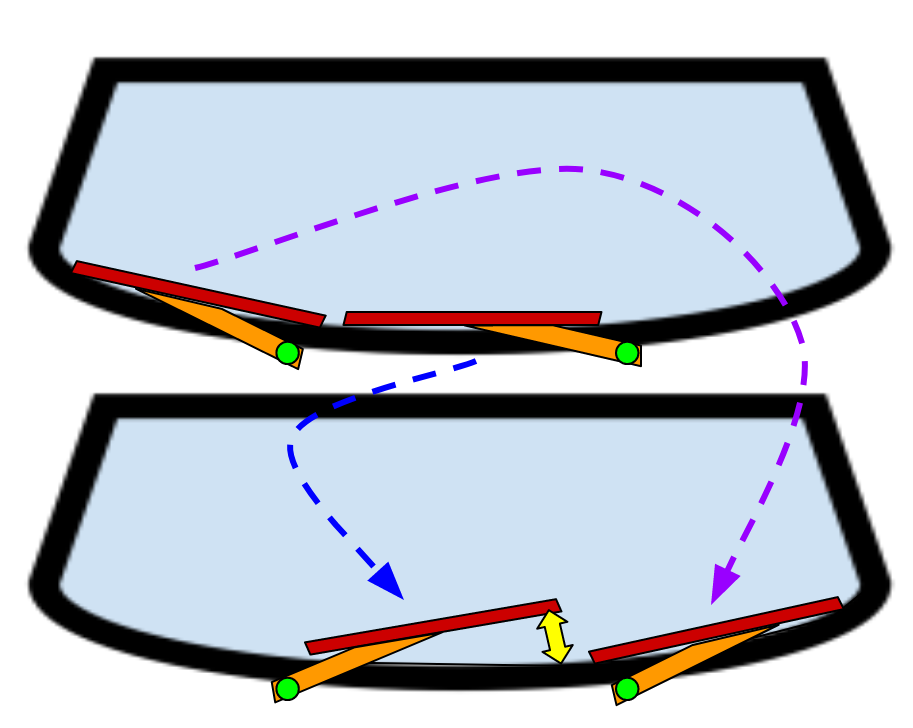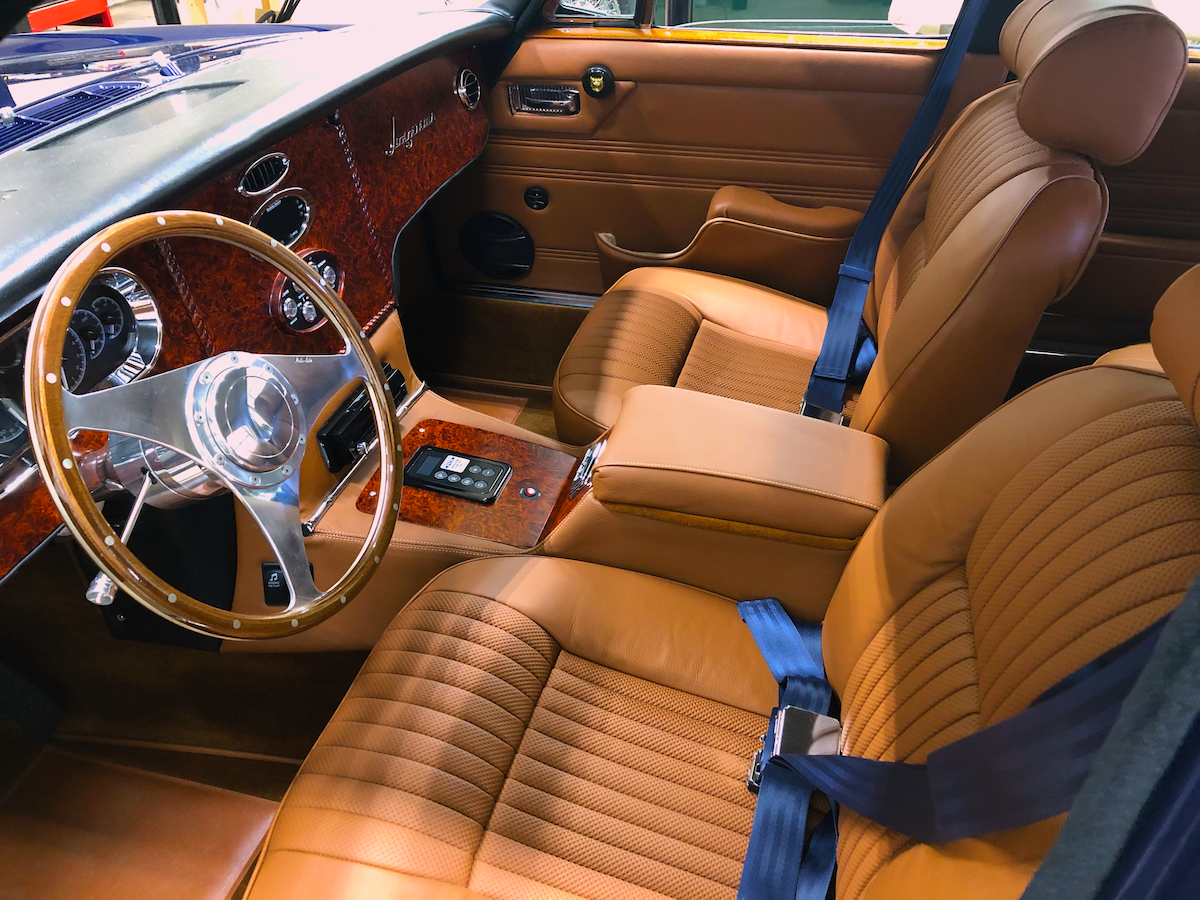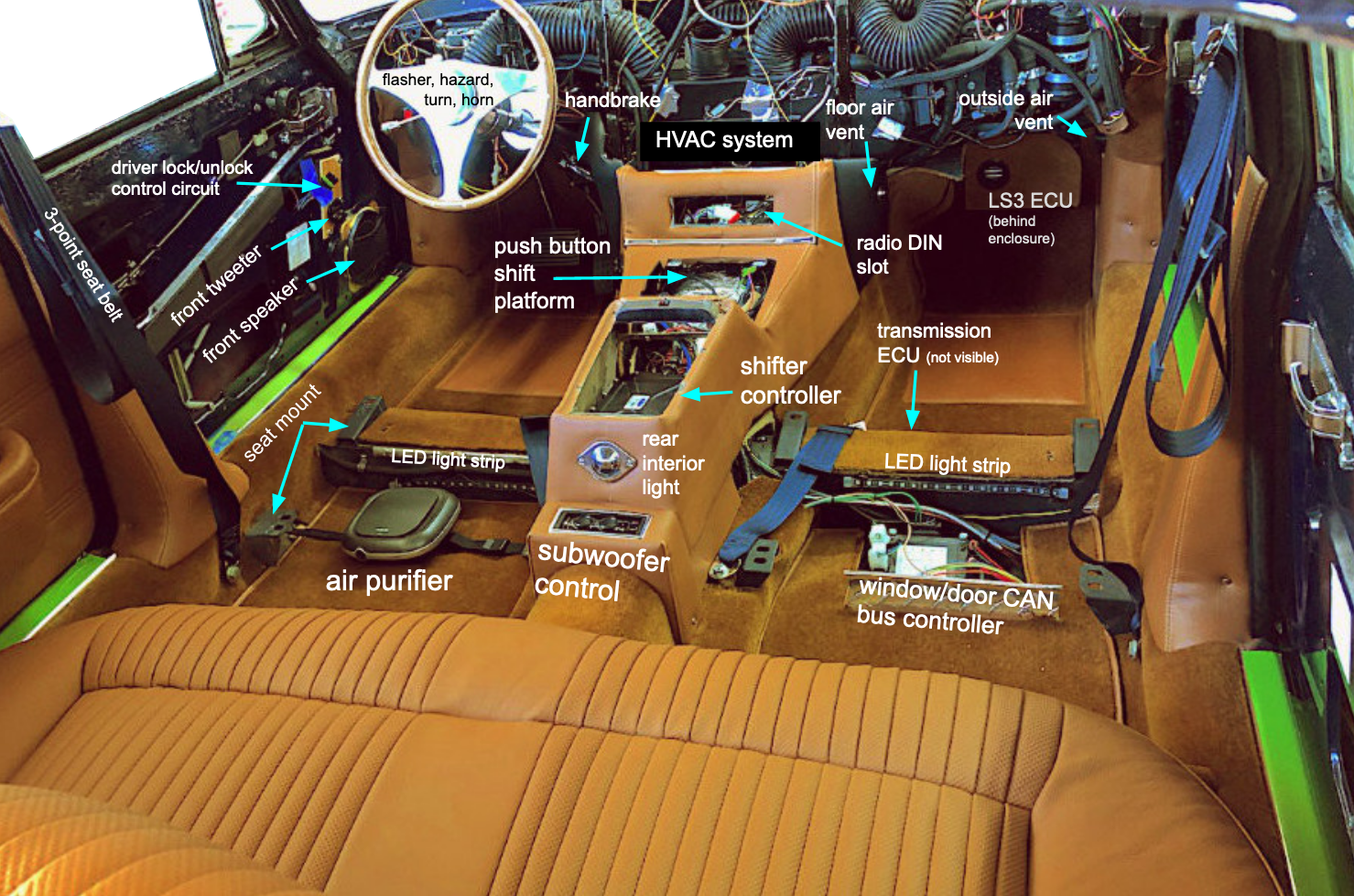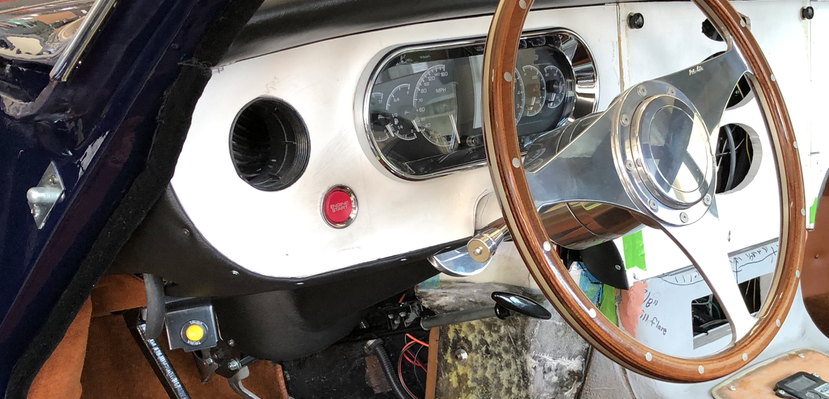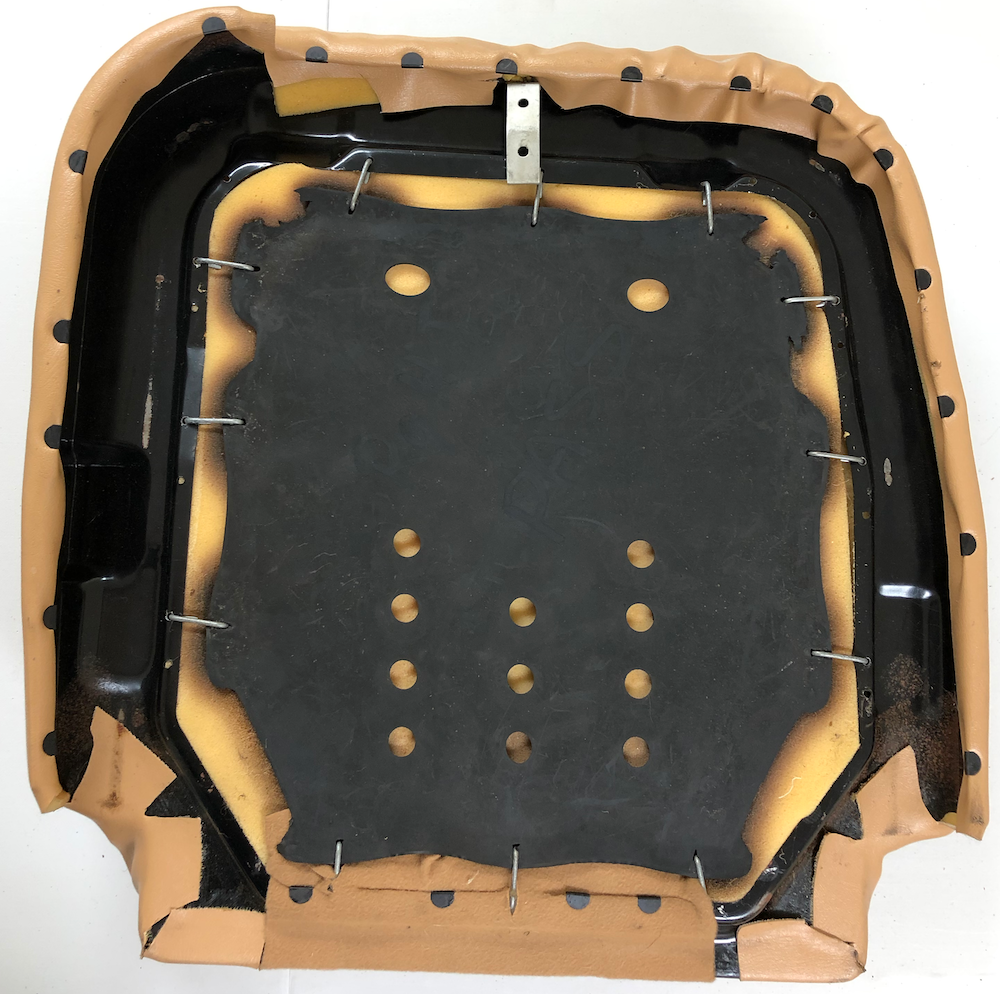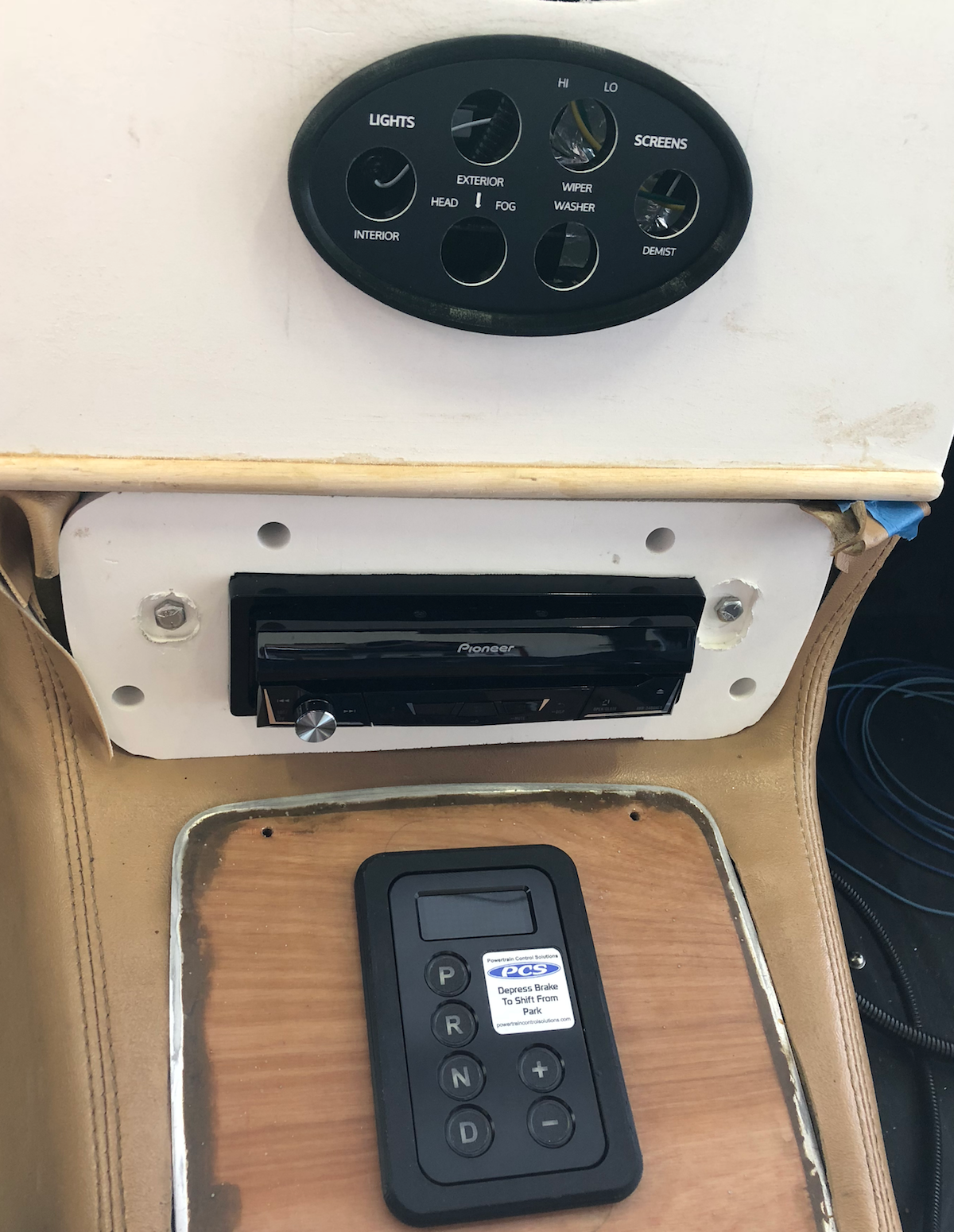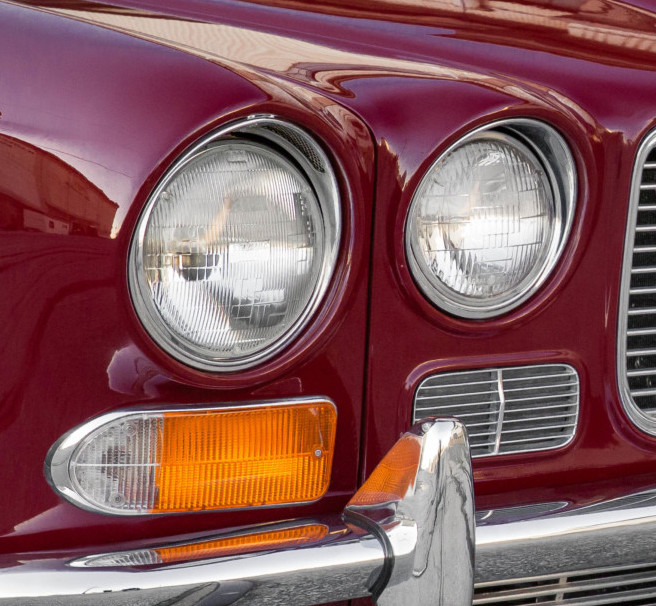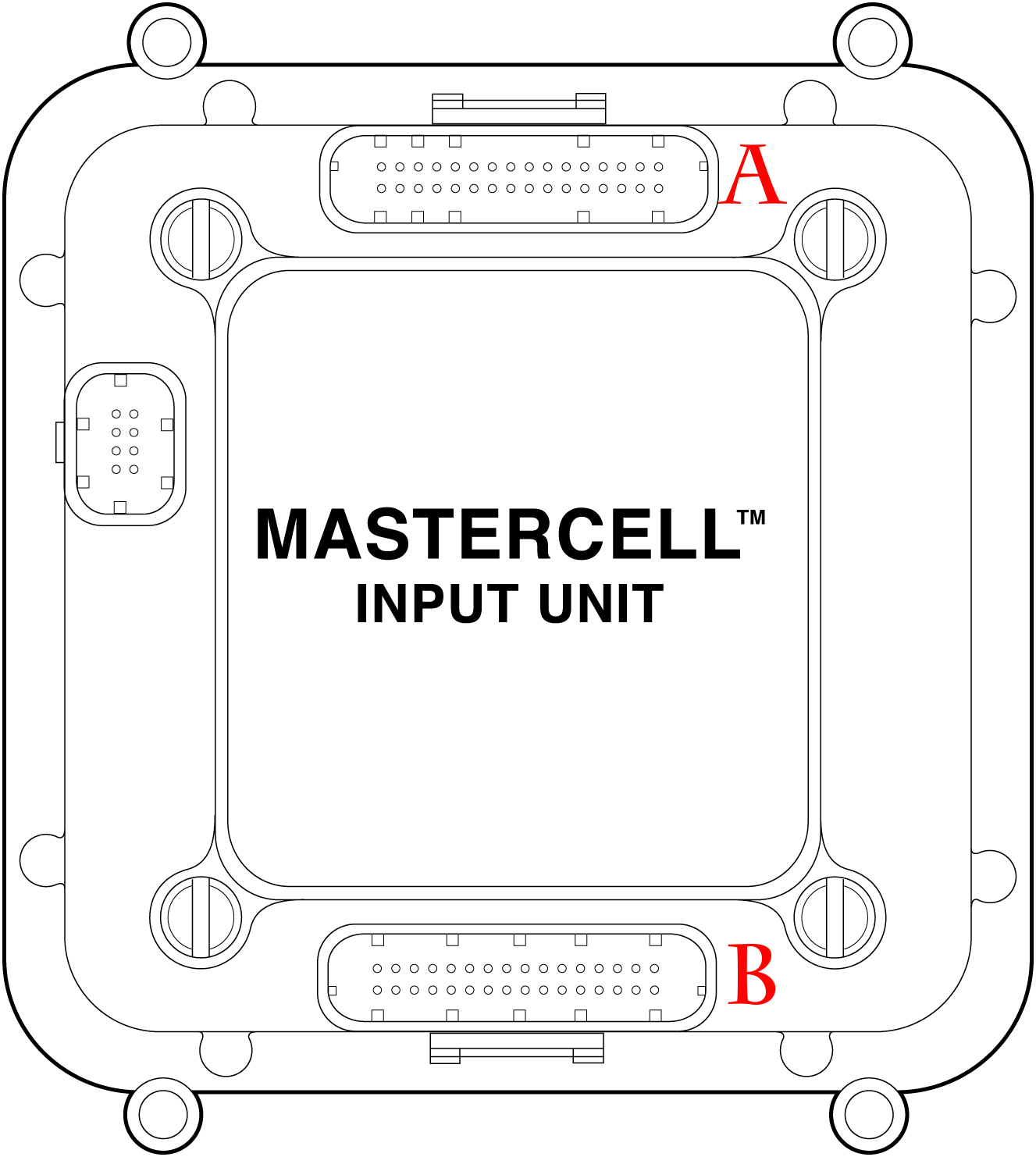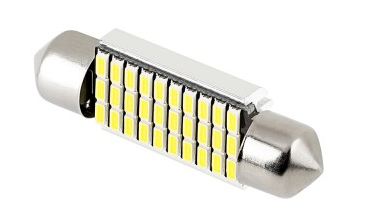Topics
Dash/console transition
The center console over the tunnel transitions into the dash with a radio face plate that is angled back about 18° from perpendicular, followed by a middle tray that separates the top gauge cluster wood facia.
The tray and top facia have black crash roll bumpers so it is difficult to see that the dash top is actually offset back an inch or so from the bottom radio face plate. This offset will need to be accommodated or modified in the final dash design.
Electronic shifting
The 4-speed SuperMatic 4L65-E transmission (mated to the LS3 engine) that we plan to install creates some opportunities with regard to the shifter assembly.
The XJ6 shifter has several drawbacks: 1) it’s ugly enough to preempt any worth preserving discussion; 2) gear selection is only mechanically driven by cable so some electronic functionality can’t be used like optional manual gear changing that requires up/+ and down/- lever slots; 3) the gear 1/2 selector is obsolete for electronic transmissions; and 4) the shift lever conflicts with the radio (entertainment unit) location.
Adding insult to injury are two useless flanking flip-up ashtrays, a cigar[ette] lighter, and a scruffy hot lighter indicator. There must be a better solution.
Performance enhancement
The notion that an automatic transmission could also behave like a manual shift emerged out of high performance experimentation about twenty years ago. Early systems were complicated — partly electronic, partly mechanical — and expensive.
With the advent of full electronic transmission control units (TCU), manual shift emulation became entirely software driven and costs dropped quickly; as a result, most premium cars now offer manual paddles or dedicated +/- slots. Since we plan to install a period-correct Jaguar style steering wheel, shift paddles may be difficult to install as well as esthetically inappropriate; to use manual mode, we’ll need a shifter with dedicated +/- slots or push button activation.
The TCU also allows the creation of “modes” based on different shift parameters in various combinations for winter/snow (1st gear lockout to avoid slipping wheels), sport/performance (delayed shifting to enhance acceleration), or dyno testing. The 4L65-E TCU is completely programmable via a laptop computer plug-in, so customized modes are possible. Not just engines are electronically tuned these days — transmissions are as well!
Shift lever fitment
Electronic control opens up a new vista regarding shift lever fitment because mechanical operations can be separated from digital control.
Most automatic shifters are about 8″ in height divided between the driver’s lever/knob and the mechanical control linkage needed to operate the hydraulics of the transmission. Electronic transmissions still require a physical cable or rod connection to change from park, reverse, neural, and drive (PRND) locations.
The “business end” of the shifter, about 4″, must be hidden by either the console or a combination of the console and a raised mount. Older style interiors typically used a raised mount shifter that kept the tunnel cover console low. The Jaguar XJ6, for example, has a raised 1.5″ platform for the shifter.
Unless the height of the entire tunnel console is raised up, space is limited between the console top and the curved tunnel of the chassis. With the popularity of flush mount shifters, the consequence is that center consoles tend to be several inches higher in modern cars compared to the 1960-70s. Sort of like chasing ones tail …
flush shifter ➜
need 4″ clearance for shift lever operation ➜
higher console ➜
won’t fit XJ6 ➜
pedestal shifter ➜
but want flush shifter ➜ now what?
Around 2012 a completely new shift design, not without controversy, began to appear in a few cars: a digital shifter that completely eliminates the traditional physical lever mechanism. This saves some space below the console surface because the shift commands can be separated from the required hydraulic cable/rod manipulations. This separation is enough to give the XJ6 a flush-mount alternative.
With the transmission “liberated” as a fully electronic device, some interesting safety features can be built in with software (or physical wiring); in an attempt to counter expected criticism, Ford proudly markets this as “Return To Park” (sounds like a sequel to a DNA-sequenced creature movie).
An electronic shifter can trigger “park” whenever 1) the ignition is shut off, 2) the handbrake is set, or 3) the driver seat belt is unfastened, the driver door is open and the vehicle is stationary (the 2017 Ford Fusion rotary shifter does this).
Design limitations
As noted above, unless the existing structure of the XJ6 dash is eliminated wholesale, there are some design constraints regarding the center tunnel console. The 1972 vintage look uses a relatively flat dash that merges into the console top as a simple L-shape. The shape transition employs end casings and underdash panels to block off gaps between the bottom of the dash the console tunnel merger.
The evolution of interior cabin design, aided greatly by CAD technology that can create all manner of complex curves, has moved towards a fusing of dash and tunnel with a fully integrated set of controls specific to the vehicle’s capabilities. Thus, retrofits of specific parts is a challenge.
Specifically, modern Jaguar interiors would be extremely difficult to “transplant” in pieces; the only way to incorporate the “fused” dash/tunnel look would be to remove the vintage 1972 original entirely. The 2017 Jaguar F-type represents an extreme tunnel-as-dash design where the traditional dashboard becomes something of an afterthought!
In addition to the fusion dash/tunnel trend, Jaguar has recently moved away from the shift lever entirely, electing to implant a rotary knob instead that retracts into the console when the ignition is off. Aftermarket Jaguar knob face covers are popping up, much like the center horn button emblems that adorn the Mk2.
In cars that retain the shift lever today, a popular look tends to minimize any difference between manual and automatic operation. After all, since the automatic can behave just like a “manual” transmission, the manual handle with boot look has become increasingly popular. But we’ll probably have to drift away from the Jaguar DNA to find an appropriate part to retrofit in.
Electronic push button
A good shifter candidate needs to meet these requirements:
- about 2.5″ clearance between console top and transmission tunnel
- attractive manual-like lever or full electronic control interface (rotary switch or push button panel)
- built-in manual shift operation capability (+/- slots or buttons)
- integrated backlit PRND position indicators
- compatible with 4L65 transmission without major modification
- symmetrical design that fits the XJ6 center console (less than 8.5 x 9.5″)
- no buttons/switches with functions that cannot be used (like ABS brakes)
- no brand identification that cannot be removed or modified
Push button controls are still a novelty — especially in the aftermarket — and the only viable entry at the moment seems to be Powertrain Control Systems (PCS) who launched their GSM “universal” controller in 2012.
The GSM push button interface, a mere 4.5 x 3.0 x 3/4″ deep panel about the size of an iPhone, connects to the GSM Cable Drive that physically moves the transmission’s mechanical gear selector in response to digital signals from the push button panel.
In addition to the expected PRND buttons, two plus and minus button can manually move transmission gearing when in drive (they are disabled in reverse). Safety features include speed limits when shifting into reverse (less than 1 mph) and drive (less than 3 mph). The brake pedal must be depressed to shift out of park, now a common requirement in current car models. Buttons are also backlit for night operations.
The small footprint of the GSM makes it possible to place the shifter virtually anywhere in the cabin.
The console shift surface also has sufficient space to place a transmission mode switch (sport or regular gear shift points) that can be programmed into the 4L65E automatic using the laptop interface. A USB port is provided in the storage area for smart phone charging. The audio phone input would also be in this location so the iPhone could be conveniently stowed while driving.
Head unit options
If push button shifting is adopted this opens up an interesting option for the single DIN radio slot. Without a shift lever conflict (and the original design directly interferes with the radio interface), a head unit with digital display becomes practical. In fact, it would even permit a retractable 7″ screen common to several single DIN units like the Pioneer AVH-3300NEX receiver.
The HVAC control and vent would need to move up enough to clear the screen top, but there is plenty of room to do this. Retractable head units can be powered by Android or Apple iPhones to provide not only entertainment, but full screen navigation via Google or Apple maps.
Armrest storage
The back end of the center shift console has an armrest with a storage area underneath formed by an odd shaped plastic insert tray, now frail and damaged, with a down slope to allow for the placement of the rear HVAC vent.
Since the vent will be eliminated (and the slope is inconvenient for cell phones anyway), some interesting possibilities arise.
A redesigned flat bottom tray with a USB charger at the front would also free up enough space to mount the GSM cable drive unit underneath. This elegantly solves the problem of the low console placement and permits the flush mounting of the GSM push button shift control.
Placing the GSM cable drive under the tray also permits a good line-of-sight for the cable and harness run itself (the cable attaches to the yellow outlet and the wiring harness to the pink interface in the drawing below).
End face
At the back of the armrest storage is an end face rear vent as well as an outdated ashtray that covers the remaining gap to the transmission tunnel. The rear ventilation tubing will not be reinstalled (it didn’t work anyway) which frees up the end face for alternative uses.
A useful accessory is a rear-facing interior light for the rear seats. The ash tray will be re-purposed to hold the controller for the audio system subwoofer.
Upholstery
The center console hardboard contour, after some modification, was first covered with 1/4″ foam before a sewn leather cover was glued in place. The leather was put through a thinning machine so that the curves and edges could be handled with a little more ease.
The gap between the lift-up armrest and the console storage area was filled with tan furflex, something that the original XJ6 design didn’t include.
An LED light on the back end now replaces the old air flow venting system.
The single DIN radio slot moves forward compared to the original, and accommodates a flip-up screen.


